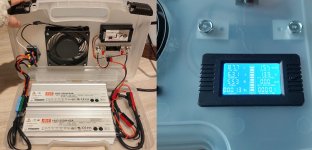I searched and found some posts that mentioned the Constant Voltage HLG-320H series drivers could be combined in Series to boost the voltage output beyond the rated voltage output of each one. I couldn't find out much more than that so I ended up emailing Meanwell's technical support with a few questions.
My motivation was that I'm looking for a relatively cheap and reliable way to charge over 600W at 24S or 100.8V maximum. Considering that I already own both a HLG-320H-42A and a HLG-320H-54A, I was particularly interested to see if these two different models could be combined, the former at 45V (it's max voltage limit) and the latter making up the difference to get 100.8V output. I'll post up the responses I got verbatim as there may have been a bit of communication/effort barrier resulting in the responses I received.
1) "We are not recommend to use two different voltage for series, that might cause damage to the driver."
Then I asked for confirmation if it was OK if two -54As could be combined in series.
2) "Yes, you can do that."
Finally I asked about combining in series two -54s at different voltages such as 50+58V just as an example.
3) "You should keep the same output voltage when combing in series."
So, the confirmation was nice, but I'm still curious about whether or not using a -42A & -54A in series would, in actuality, result in damage as "might cause damage" was not a definitive answer IMO. It could be that the technician that answered me is just playing it safe and the risk is negligible, but I don't have the background to say one way or the other. I'm not willing to risk damage to these drivers as I use them both for different tasks, but I thought I'd pose the question to any electronic gurus before I go out and buy a second -54A unit.
Any guesses if this concern is valid and what electrical component(s) within the charger(s) are at risk for running both drivers at different voltages to combine their output in series?
My motivation was that I'm looking for a relatively cheap and reliable way to charge over 600W at 24S or 100.8V maximum. Considering that I already own both a HLG-320H-42A and a HLG-320H-54A, I was particularly interested to see if these two different models could be combined, the former at 45V (it's max voltage limit) and the latter making up the difference to get 100.8V output. I'll post up the responses I got verbatim as there may have been a bit of communication/effort barrier resulting in the responses I received.
1) "We are not recommend to use two different voltage for series, that might cause damage to the driver."
Then I asked for confirmation if it was OK if two -54As could be combined in series.
2) "Yes, you can do that."
Finally I asked about combining in series two -54s at different voltages such as 50+58V just as an example.
3) "You should keep the same output voltage when combing in series."
So, the confirmation was nice, but I'm still curious about whether or not using a -42A & -54A in series would, in actuality, result in damage as "might cause damage" was not a definitive answer IMO. It could be that the technician that answered me is just playing it safe and the risk is negligible, but I don't have the background to say one way or the other. I'm not willing to risk damage to these drivers as I use them both for different tasks, but I thought I'd pose the question to any electronic gurus before I go out and buy a second -54A unit.
Any guesses if this concern is valid and what electrical component(s) within the charger(s) are at risk for running both drivers at different voltages to combine their output in series?


